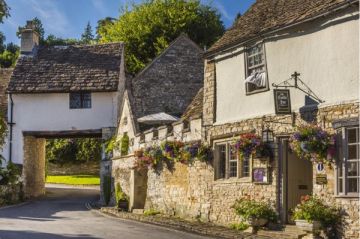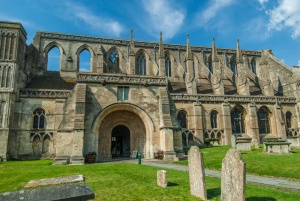
Malmesbury Abbey is one of the oldest and most important religious sites in England, with a history going back to at least the 7th century. As early as AD 603 a nunnery was established in the hilltop Saxon town of Malmesbury. Some three decades later the Irish monk Maidulph founded a simple hermitage and school on the site.
St Aldhelm
One of Maidulph's students was Aldhelm, a relative of King Ina of Wessex. Aldhelm completed his studies at Canterbury and returned to Malmesbury where he served as the head of the school following Maidulph's death. Around AD 675 Leutherius, Bishop of Dorchester, re-founded the hermitage as a fully-fledged monastery as Aldhelm served as its first abbot.
He was responsible for making Malmesbury a centre of scholarship and is credited with building the first organ in England, described as a 'mighty instrument with innumerable tones, blown with bellows, and enclosed in a gilded case'.
After his death, Aldhelm was canonised as St Aldhelm, the first saint of Wessex. By the 10th century, Aldhelm's monastery was a Benedictine house.
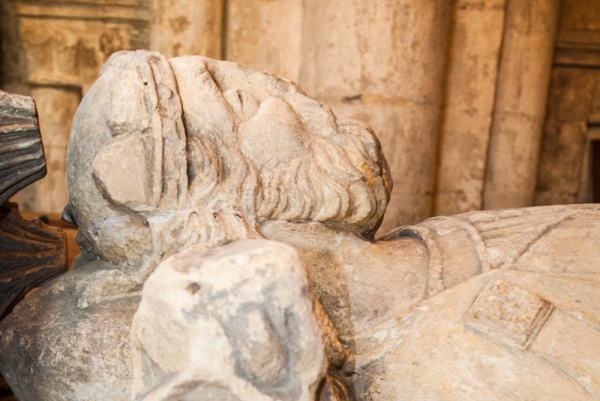
King Athelstan
One of the Abbey's early patrons was Athelstan, the grandson of Alfred the Great. Athelstan gave money to expand the church and also donated books - a rare and valuable commodity in the Saxon period. Perhaps more importantly, he gave the monks religious relics.
The relics made Malmesbury Abbey a popular destination for pilgrims, and the pilgrims made the Abbey wealthy with donations. When Athelstan died in 939 he was buried in the abbey church. His worn tomb, topped by an effigy of the king, still exists It is one of the oldest stone effigies in Europe.
The king's effigy lies in the north aisle, but the tomb beneath it is empty. According to William of Malmesbury (see below) Athelstan's body was exhumed and reburied in the Abbot's private garden.
Around 1118 (some versions suggest a much later date around 1145) Bishop Roger of Sarum (Salisbury) began rebuilding the abbey. It took several decades to complete the abbey church, which was consecrated around 1180.
Bell tower
Malmesbury Abbey is one of the few English churches with a completely detached, free-standing bell tower. See Berkeley, Gloucestershire for another example.
The bell tower is used by the local bell-ringing group. I had the pleasure of being invited to attend a bell-ringing session in the tower and it was quite an experience!
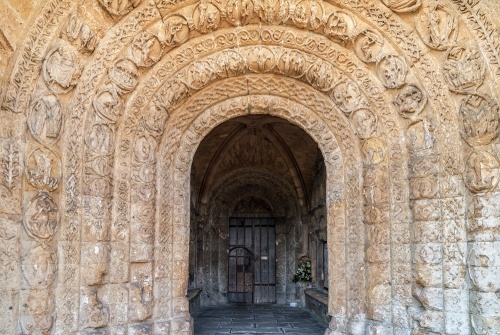
William of Malmesbury
William of Malmesbury (1095-1143) was perhaps the first great British historian. William was educated in the abbey's school and joined the Abbey as a monk after his education was complete. He wrote detailed and accurate historical accounts, relying on original source material and eye witness accounts.
This alone sets him apart from most monastic chroniclers who were more concerned with promoting their own agendas rather than historical accuracy. William's greatest work was Gesta Regum Anglorum (The Chronicle of the Kings of England), covering the period from 449 to 1127.
The Flying Monk
One of William of Malmesbury's most intriguing stories tells the tale of an early 11th-century monk named Eilmer or Elmer. Eilmer read the Greek fable of Daedalus and Icarus and their tragic attempt to fly.
He studied jackdaws and noticed how they navigated on air currents. He decided to make 'wings' of an unknown material that he could fasten to his wrists. The wings, he reasoned, would enable him to flap his arms like a bird and catch the air currents.
He climbed to the top of the abbey tower and launched himself into the air, flapping his manufactured wings. Far from being a disaster, he managed to 'fly' for some 200 metres before crashing to the ground. He broke both his legs, leaving him crippled for life. His injuries did not stop Eilmer from planning another attempt, but when the abbot got wind of his plans he firmly forbade any more attempts.
The 12th-century abbey was much larger than the partial remains we see today; The nave stretched 12 bays long; nine to the west and three to the east of a central tower. The west end of the nave terminated in a striking pair of towers. The west end of Malmesbury Abbey is thought to have inspired Salisbury Cathedral's west end.
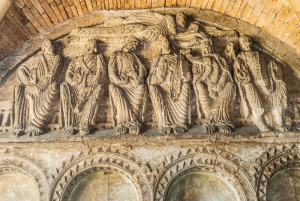
The south porch, facing the town, is simply staggering for the beauty and complexity of its carving. This is easily among the finest examples of 12th-century architecture in Britain, possibly in Europe. It is possible that skilled masons from Chartres were imported to work on Malmesbury Abbey's south porch.
Wherever the masons came from, they earned their pay, for the carvings are extraordinary. The outer doorway is carved with scenes illustrating a 4th-century poem called Psychomachia and depict the Battle of the Virtues and Vices.
The porch interior is carved with figures of angels and apostles, and over the inner door is a tympanum depicting Christ in Majesty.
Fourteenth-century additions to the abbey church included a west tower with a spire 30 feet higher than Salisbury's. The spire, made of timber sheathed in lead, was topped by a large golden ball. Unfortunately, the tall spire was struck by lightning in the late medieval period and came crashing down into the High Street.
The Abbey was caught up the tumult of the Civil War. Cannons were hauled to the top of the west tower by Royalist soldiers to defend the town from a Parliamentary assault. It did not help, for Malmesbury fell to Parliament (twice).
A grim reminder of the Civil War conflict is a series of bullet holes in the south wall of the porch. These holes mark the sport where Royalist prisoners of war were executed.
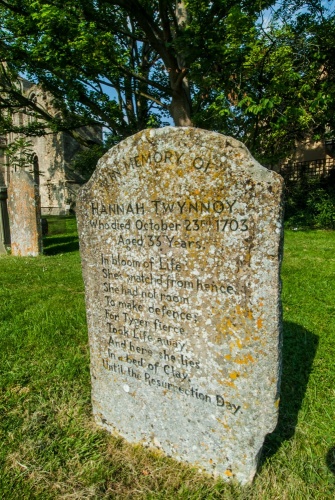
A Tiger's Tale
In the graveyard is a curious gravestone commemorating a local barmaid named Hannah Twynnoy (d. 1703). The gravestone tells how poor Hannah was killed by a tiger that had escaped from a travelling circus.
In the bloom of life
She’s snatched from hence
She had not room
To make defence
For tiger fierce
Took life away
And here she lies
In a bed of clay
Until the resurrection day
There is a problem with the dramatic account of Hannah Twynnoy's demise; it is not told in any contemporary accounts. You would think that such a dramatic and tragic event would be the talk of the town for years, but there is no mention of the tiger in contemporary documents. More curiously; how did a poor woman's family pay for such an elaborate gravestone? One suggestion is that Hannah had a wealthy lover, but again, there is no proof one way or the other.
Abbey House Gardens
The abbey was suppressed by Henry VIII in 1539 and the abbot and monks were pensioned off. The site was sold to William Stumpe, who gave the Abbey church to the town to serve as the parish church. He kept the other monastic buildings to use in his cloth business.
Stumpe converted the 13th-century Abbot's house into a wonderful Tudor home now known as Abbey House. The five acres surrounding the house are now a delightful modern garden called Abbey House Gardens.
Getting There
There are two major public car parks in Malmesbury, both well signposted from roads into the town. I suggest the long stay car park on Station Road, though the short-stay car park on Cross Hayes is even closer to the Abbey.
About Malmesbury Abbey
Address: Gloucester Street,
Malmesbury,
Wiltshire,
England, SN16 0AA
Attraction Type: Historic Church
Website: Malmesbury Abbey
Email: office@malmesburyabbey.com
Location
map
OS: ST932873
Photo Credit: David Ross and Britain Express
HERITAGE
 We've 'tagged' this attraction information to help you find related historic attractions and learn more about major time periods mentioned.
We've 'tagged' this attraction information to help you find related historic attractions and learn more about major time periods mentioned.
Find other attractions tagged with:
NEARBY HISTORIC ATTRACTIONS
Heritage Rated from 1- 5 (low to exceptional) on historic interest
Abbey House Gardens - 0.1 miles (Garden) ![]()
Tetbury, St Mary the Virgin - 4.4 miles (Historic Church) ![]()
Westonbirt House - 4.5 miles (Historic House) ![]()
Tetbury, St Saviour's Church - 4.6 miles (Historic Church) ![]()
Westonbirt Arboretum - 5 miles (Garden) ![]()
Draycot Cerne, St James Church - 5.4 miles (Historic Church) ![]()
Leigh Delamere Church - 5.8 miles (Historic Church) ![]()
Windmill Tump - 6.2 miles (Prehistoric Site) ![]()



